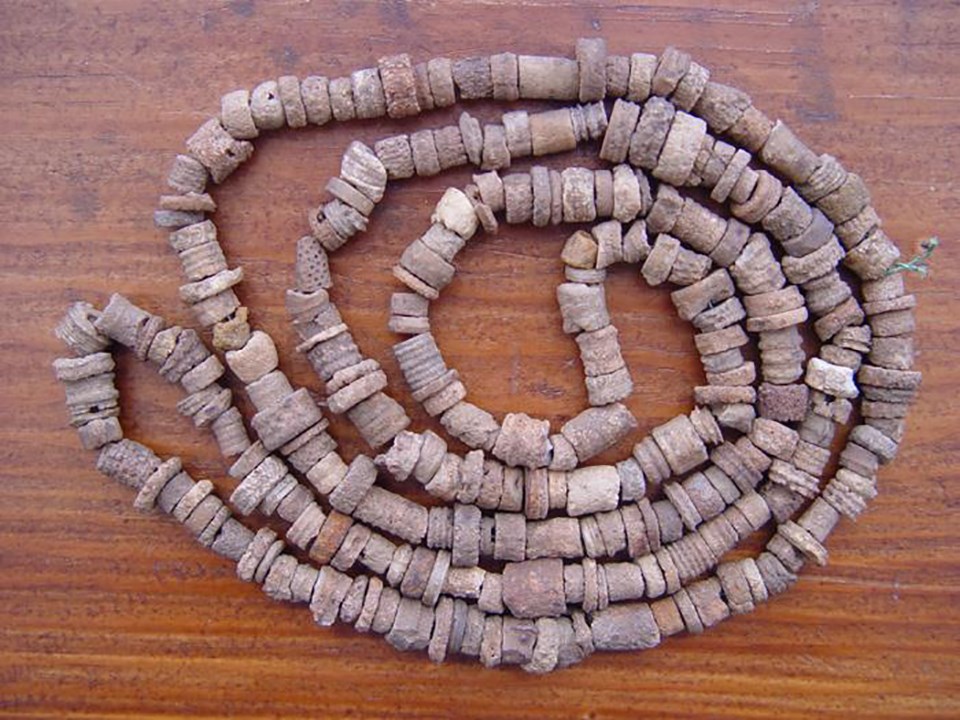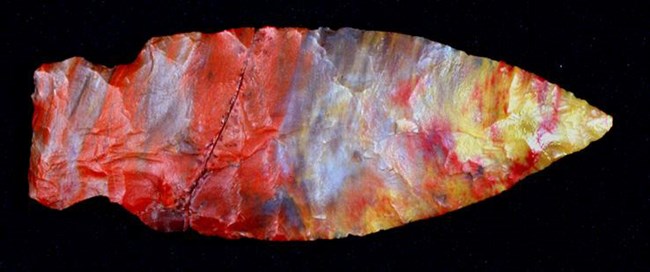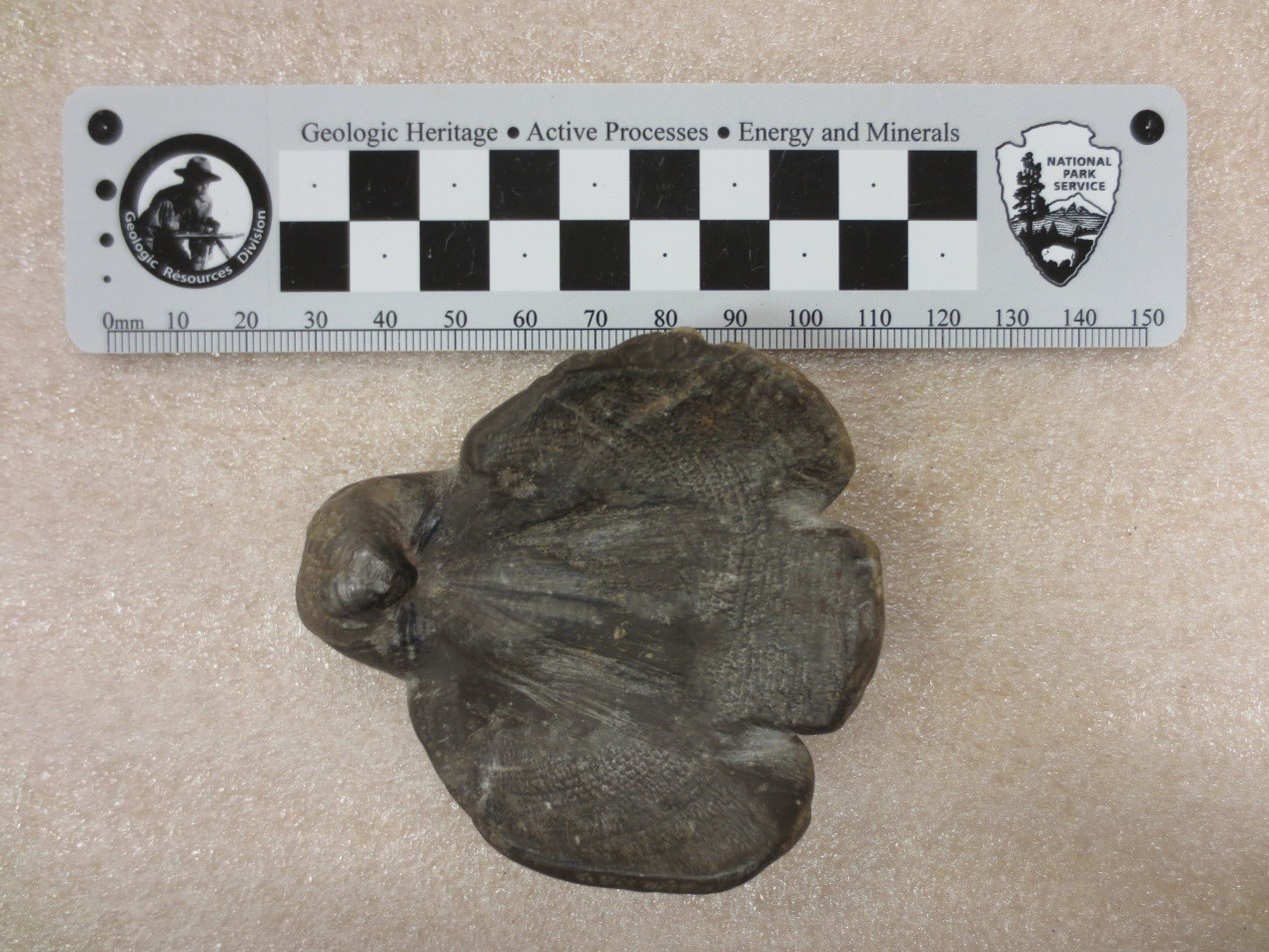History of Paleontology in the National Park Service—Santucci, V. L. (page 2 of 9)

NPS photo.
Introduction
The question of how far back in time to begin a historical review of paleontology and the national parks is worth consideration. In the broadest sense and interpretation, the study of paleontology is a human undertaking involving fossils. In North America, there is evidence of human interactions with fossils that date back thousands of years. Archeological discoveries demonstrate and document the use of paleontological specimens by prehistoric Native Americans.

Projectile points manufactured from petrified wood and tools fashioned from fossil bones or shells are not uncommon in the archeological record. Fossils used to produce what appears to be jewelry, effigies and spiritual objects are contained in archeological collections, including collections maintained by the National Park Service (Kenworthy and Santucci 2006).
This historical overview of National Park Service paleontology includes information which extends back to the earliest evidence of humans in North America during the Late Pleistocene. One of the oldest well-dated records of humans in North America, referred to as ‘Arlington Springs Man’, was found on Santa Rosa Island, which is part of Channel Islands National Park, California (Orr 1962). There is a wealth of scientific literature concerning archeological sites in North America that yield evidence of interactions between Paleoindians and Late Pleistocene megafauna (Haynes 1966; Agenbroad 1980; Fisher 1984, 1987; Fox et al. 1992; Hoppe 2004). The decision to include fossils from archeological sites, exhibiting use or alteration by humans, in this paper is based on several factors. First, these specimens preserve interesting and important historic information pertaining to fossils which may be useful in research or public education. Additionally, the presentation of this information may result in other investigators recognizing, documenting and reporting on similar occurrences of fossils which show evidence of human use or alteration. Finally, the intent of this website is to establish a comprehensive framework for future study related to the history of National Park Service paleontology and thus the widest scope of potential sources of data and information has been included. Therefore, this section titled ‘Pre-Columbian Period’ is inclusive of information which spans between the first migrations of humans into the New World sometime during the Late Pleistocene until the arrival of European explorers in the late 15th century.
Fossils Discovered in an Archeological Context
Kenworthy and Santucci (2006) presented an inventory of paleontological resources within cultural resource contexts documented from National Park Service areas. Relevant occurrences exist throughout the United States and take many forms. A number of parks in the Four Corners area of the American Southwest maintain collections of fossils, primarily petrified wood, which exhibit evidence of use or modifications by humans. Many of these specimens were obtained through archeological surveys undertaken in parks including: Canyon de Chelly National Monument and Petrified Forest National Park in Arizona; Mesa Verde National Park in Colorado; and Aztec Ruins National Monument, Bandelier National Monument, Chaco Culture National Historical Park and Salinas Pueblo Missions National Monument in New Mexico.
Humans have been present in the American Southwest for at least 12,000 years (Haynes 1969; Martin 1973; Meltzer 1983; Hurt 1990). Thousands of individual specimens of human-modified petrified wood have been collected from National Park Service areas in the Four Corners area. The National Park Service curatorial records associated with these collections identify the petrified wood artifacts as projectile points, scrapers, bifaces, knives, flakes, cores, gravers, burins, drills, hammerstones, choppers, pecking stones, abraders, polishing stones, and debitage (Tweet et al. 2009). A few ornamental or ceremonial objects made from fossils are also within the collections of the southwestern parks, including pendants from Aztec Ruins National Monument and Petrified Forest National Park, a bracelet from Chaco Culture National Historical Park; and effigies carved into fossil invertebrates including a bird effigy carved into a fossil brachiopod from Salinas Pueblo Missions National Monument (Hayes et al. 1981).

NPS photo by J. Tweet.
Similar pre-Columbian artifacts made from fossils have been documented from National Park Service areas in the central portion of the United States. Hopewell Culture National Historical Park, Ohio, has collections of fossil shark teeth and other fossils discovered in the mortuary offerings of prehistoric Native Americans. Thirteen fossil shark teeth are believed to have been incorporated into a necklace. Age dating of these archeological resources indicates these artifacts date between 200 BC to AD 500, during the Middle Woodland period. At Effigy Mounds National Monument, Iowa, a collection of crinoid columnals were discovered in a rockshelter. These fossil remains suggest the crinoids were used as jewelry objects by prehistoric Woodland Period Indians (Hunt et al. 2008).
George Washington Birthplace National Monument, Virginia, is an example of an eastern park which preserves pre-Columbian occurrences of fossils showing evidence of humans being aware of these resources and possibly handling or using them in some manner. Fossil shark teeth have been documented in direct association with shell middens at the monument. The middens date to the Late Archaic (approximately 5,000–3,200 years before present), Middle Woodland (approximately 2,500–1,100 years before present), and Late Woodland (approximately 1,100–400 years before present) periods. Fossil shark teeth are commonly found in the Calvert Formation (Miocene) which is exposed in the monument (R. Morawe, personal communication, 2005).
The documentation of fossils associated with pre-Columbian humans may provide evidence of long-distance transport and trade between prehistoric cultures. Many fossil taxa have limited geographic occurrences. The discovery of fossils in geographic areas which are far from the geologic strata in which the fossils were preserved may yield important historic and archeological information about ancient populations and their activities. Fossil Glycymeris (clam) shells found at Snaketown, an archeological site at Hohokam Pima National Monument, Arizona, are believed to have been procured from the Gulf of Mexico (Haury 1976).
1492–1800
Colonial & Early National
Related Links
-
Aztec Ruins National Monument (AZRU), New Mexico—[AZRU Geodiversity Atlas] [AZRU Park Home] [AZRU npshistory.com]
-
Bandelier National Monument (BAND), New Mexico—[BAND Geodiversity Atlas] [BAND Park Home] [BAND npshistory.com]
-
Canyon de Chelly National Monument (CACH), Arizona—[CACH Geodiversity Atlas] [CACH Park Home] [CACH npshistory.com]
-
Chaco Culture National Historical Park (CHCU), New Mexico—[CHCU Geodiversity Atlas] [CHCU Park Home] [CHCU npshistory.com]
-
Effigy Mounds National Monument (EFMO), Iowa—[EFMO Geodiversity Atlas] [EFMO Park Home] [EFMO npshistory.com]
-
George Washington Memorial Parkway (GWMP), Maryland and Virginia—[GWMP Geodiversity Atlas] [GWMP Park Home] [GWMP npshistory.com]
-
Mesa Verde National Park (MEVE), Colorado—[MEVE Geodiversity Atlas] [MEVE Park Home] [MEVE npshistory.com]
-
Petrified Forest National Park (PEFO), Arizona—[PEFO Geodiversity Atlas] [PEFO Park Home] [PEFO npshistory.com]
-
Salinas Pueblo Mission National Monument (SAPU), New Mexico—[SAPU Geodiversity Atlas] [SAPU Park Home] [SAPU npshistory.com]
Last updated: December 4, 2023
